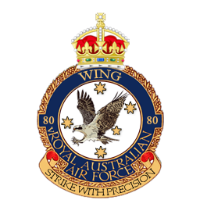Rules
VIRTUAL ROYAL AUSTRALIAN AIR FORCE
No. 80 Wing
CODE OF CONDUCT
19 JAN 25
No. 80 Wing vRAAF is the parent unit to No. 66 Squadron and No. 76 Squadron. It is required that all Serving Members and associates accept and abide by the Code of Conduct below:
OUR STANDARDS
1. Demonstrating empathy and kindness toward other people;
2. Being respectful of differing opinions, viewpoints, and experiences;
3. Giving and gracefully accepting constructive feedback, charitably interpreting others' words;
a. This includes feedback pertaining to any training provided by No. 80 Wing vRAAF, it’s subordinate Squadrons, or it's Serving Members.
b. It is important that those providing constructive feedback ensure that the recipient of the feedback understands that it is intended as constructive.
c. It is required of those interacting with No. 80 Wing vRAAF on their services, that they understand that this constructive feedback is intended to improve their skills as aviators.
4. Accepting responsibility and apologizing to those affected by our mistakes, and learning from the experience;
5. Focusing on what is best not just for us as individuals, but for the overall community; and
6. Respecting everyone's consent and boundaries:
a. This includes if you are streaming content to third-parties, you MUST announce that you are doing so.
b. If you are uncomfortable with someone streaming content, you MUST make yourself known to the streaming party as soon as practicable.
REPRESENTING No. 80 WING, SUBORDINATE SQUADRONS AND THE vRAAF
1. Serving members of No. 80 Wing vRAAF and its subordinate Squadrons are expected to carry themselves with due diligence when they are wearing their Squadron tags and Tactical Callsigns. It is the equivalent of wearing a uniform in public, and that they are representing the Wing, their respective Squadrons and the vRAAF as a whole.
2. It is expected that behavioural standards are met in the public eye, or disciplinary action from a Squadron or Wing level may result as a consequence of failure to do so.
EXAMPLES OF UNACCEPTABLE BEHAVIOUR
1. Bullying, public or private harassment;
2. Discrimination of any kind regarding age, race, religion, gender, sexual preference or disability;
3. Publishing others' private information without their explicit permission;
4. Other conduct which could reasonably be considered inappropriate in a professional setting; and
5. Attempting to justify negative behaviour by arguing the details of this Code of Conduct.
ENFORCEMENT RESPONSIBILITIES
1. Community Leaders (moderators and administrators) are responsible for clarifying and enforcing our standards of acceptable behaviour and will take fair corrective action in response to any behaviour they deem inappropriate, threatening, offensive or harmful.
2. Community leaders have the right and responsibility to remove messages and content that are not aligned to this Code of Conduct, and will communicate reasons for moderation decisions when appropriate to parties that are responsible or affected when appropriate.
ENFORCEMENT PROCEDURES
1. Depending on the severity of the unacceptable behaviour will determine the level of enforcement used to remedy the issue. Those levels of enforcement are:
a. Correction:
(i) This is the lowest form of corrective action, and is intended to provide parties involved a reminder of the Code of Conduct.
b. Warning:
(i) This is an official advisement of belligerent parties that they are on notice for unacceptable behaviour, and that any further violations of the Code of Conduct will result in harsher punitive action.
c. Temporary Ban.
(i) This is used when a serious violation of the Community Standards occurs, including sustained unacceptable behaviour.
(ii) The duration of the ban is measured based off the severity of the violation, and how many times in the past that the belligerent party has been cited for unacceptable behaviour.
(iii) Unsolicited contact with parties involved, or further escalation of the incident(s) by inciting others to act on the belligerent party's behalf may result in further actions such as a permanent ban, and will result in third parties being subject to punitive action.
d. Permanent Ban.
(i) Demonstrating a pattern of unacceptable behaviour by violating the Code of Conduct, or absolute wilful disregard for the Community Standards will result in a permanent ban from No. 80 Wing vRAAF services.
(ii) If the severity of the actions committed by the belligerent party are offenses under Australian Law, law enforcement may be contacted, and evidence of these offenses provided to them.
<Original Signed>
SHADOW
Group Captain (vRAAF)
Commanding Officer No. 80 Wing vRAAF


